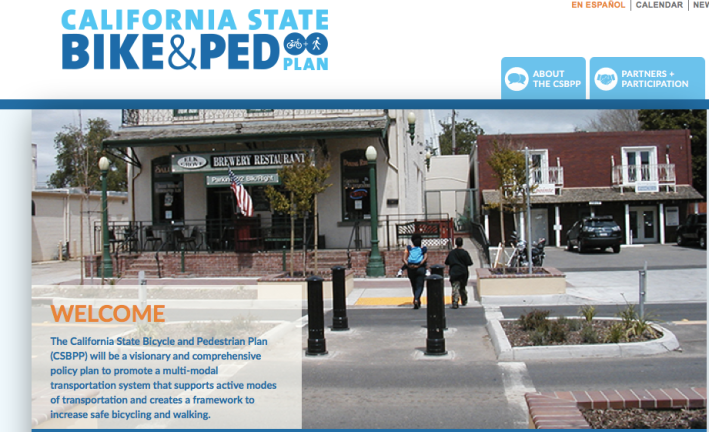

As part of the process to develop the first-ever statewide bike and pedestrian plan, Caltrans has been collecting general information from people about their current walking and bicycling experience. The survey, available here, closes on June 30.
So far the department has collected about 2,500 responses from around the state. The information will be used to help formulate a draft California State Bike and Ped Plan, with the completed plan due in February 2017.
While at the State Bike and Ped Plan website, sign up for updates on the next phase of public outreach. A webinar about the plan is being put together for some time in late July or August. When the draft plan is released this fall, there will be “another round of public engagement,” according to Scott Forsythe, who is managing the effort for Caltrans.
The plan's website is also due for an update in the next few weeks.
So far Caltrans has held ten regional workshops—well, nine, with the tenth happening in Eureka tomorrow—with local agency partners to gather feedback about coordinating on bike and pedestrian issues. The regional workshops gathered about 170 representatives from cities, counties, metropolitan planning organizations, health departments, and law enforcement agencies. Bicycle and pedestrian advocates were invited to attend as well. See earlier SBCA coverage of a recent state plan workshop in Los Angeles.
The regional forums were an “early outreach effort,” according to Forsythe. A summary of the input from the forums will inform the draft plan. Then, in the fall, “there will be further opportunities for public input to the plan. We're still looking for the best way to reach out to get the most effective input,” said Forsythe.
Currently Caltrans is developing draft objectives for the plan, with the help of a technical advisory committee made up of representatives of about forty planning agencies, state agencies, and advocates. The advisory committee “is a good cross section of California,” said Forsythe. “It includes representatives from urban areas and rural areas, mountain communities, coastal communities.” The advisory committee provides feedback on the draft objectives, and will help with developing strategies to meet those objectives and performance measures to evaluate whether they are being met.
The plan's objectives are based on the six goals already developed for the statewide California Transportation Plan 2040. “There was an extensive statewide effort to develop the CTP goals,” said Forsythe, “and they apply to this plan.”
The goals in the CTP are a good start for a bike/ped plan. They are to:
- Improve multimodal mobility and accessibility for all people
- Preserve the multimodal transportation system
- Support a vibrant economy
- Improve public safety and security
- Foster livable and healthy communities and promote social equity
- Practice environmental stewardship
The effort of creating a statewide plan can seem more than a little wonky and far away from the day-to-day experience of the streets. It is possible that Caltrans, working on a statewide level, may end up producing a plan which seems generic. But it will also lay the groundwork for how local districts and cities integrate bicycle riders and pedestrians into whatever the future transportation system looks like.
It will also be used by and referred to by advocates and planners if they need to remind Caltrans—or their own local transportation planning departments—that the state has the goal of creating better infrastructure for safer, healthier communities.
The better this plan turns out, the better the future of California cities will turn out. Do your part by taking the online survey now.





